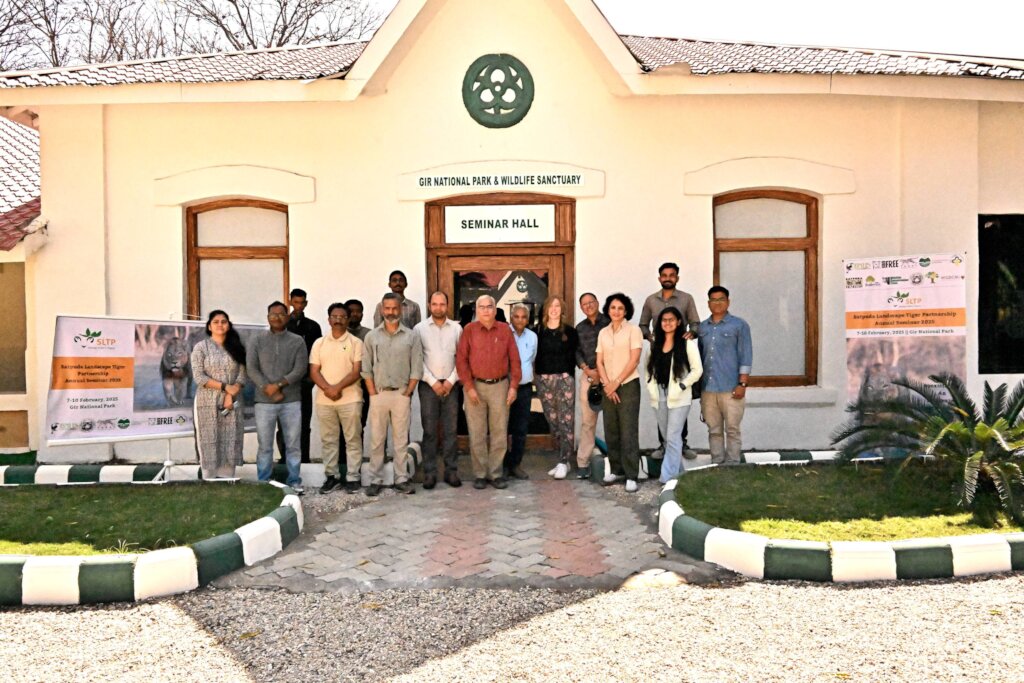By Born Free | Born Free Foundation
In February, the Satpuda Landscape Tiger Partnership came together for their annual seminar which allows partners to share, engage and learn about the work each other is doing. This year, the seminar was held in Gir Forest National Park and Wildlife Sanctuary in northwestern India. In the Gir Forest and surrounding area, live the only population of wild Asiatic lions.
Fewer people might be aware of the presence of lions in Asia. Originally,they were thought to be a sub-species, as Asiatic lions (previously classified as Panthera leo persica, now Panthera leoleo) are slightly smaller, and have a less bushy mane, particularly on the top of the head, compared with African lions. However, further research has found that Asiatic lions are more closely related to Western and Central African lions than these populations are to Eastern and Southern African lions.
The Asiatic lion used to roam across the Indian subcontinent, as well as parts of Central Asia, such as Iran, Pakistan and parts of Afghanistan. Now they are separated from African lions by 3000km and the Arabian Sea, only living in a corner of northwestern India.
As a result of intense hunting and rapid habitat loss, lion numbers dramatically reduced and were extirpated from much of their range by the early 19th century. Thankfully, at the end of the 1800s, the Gir forest area, India, was declared a protected area for the lions, and in 1965, it became a national park. In 1968, fewer than 200 lions were living in the wild, however thanks to conservation work and increased protections, the Asiatic lions have made a stunning comeback. Now an estimated 674 live in and around Gir National Park today.
While the SLTP network’s usual focus is on tigers, and they come together on their annual seminar to share ideas and thrash out solutions to challenges around tiger conservation in India, this year, they embraced spending a few days learning about and observing another Asian big cat species for a change. Though different in many ways – ecology, behaviour, reputation – the conservation of lions and tigers has some similarities and shared challenges that the SLTP partners were keen to learn from those involved in implementing this highly functional operation.
Gujarat State Forest Department manages Gir National Park, the tourist venture and the conservation of the lions – and represents a very impressive conservation outfit in India with the Asiatic lion being a flagship species for conservation. With 60,000 tourists visiting the park annually, Gir and its lions are hugely valued by the Indian government and receive a healthy annual budget for operations.Despite only having one protected area in the Gujarat State, they received around 20,000,000 rupees (approx. 180,800 GBP) for 2022-2023, a similar amount to that received by states that have eight or more protected areas.
The lion’s comeback means they’re living at fairly high density in Gir National Park today.Their behaviour combined with the open dry habitat of Gir in February, means that they were easy to spot. During the wildlife drives that the team made as part of the SLTP meet-up in Gir, they were very fortunate to have a few excellent lion sightings.
As conservationists, the Gir lion’s story gives us hope and provides opportunities to learn. However, this population is far from safe – in relatively low numbers (compared with the 20,000 estimated lions living in Africa) and living in a single isolated population, they remain vulnerable to extinction. Efforts and plans to translocate individuals elsewhere in India to encourage additional populations have been considered in the past but have not taken place. Any flare up in conflict with local people could risk leading to retaliatory attacks on the lions.
The SLTP partners learnt a lot during their visit to Gir – and one thing that loomed large was the importance of public understanding and acceptance. Asiatic lion conservation appears to be hugely successful – the upcoming census planned for May 2025 will serve to demonstrate the impact of the last 5 years of efforts on the population – but living in increasingly close proximity with a growing human population, such large and potentially dangerous animals will always be vulnerable. With careful and sustained efforts, the Gir lions will persist for many more years, and we can continue to learn from their success.
Links:
Project reports on GlobalGiving are posted directly to globalgiving.org by Project Leaders as they are completed, generally every 3-4 months. To protect the integrity of these documents, GlobalGiving does not alter them; therefore you may find some language or formatting issues.
If you donate to this project or have donated to this project, you can receive an email when this project posts a report. You can also subscribe for reports without donating.
Support this important cause by creating a personalized fundraising page.
Start a Fundraiser
